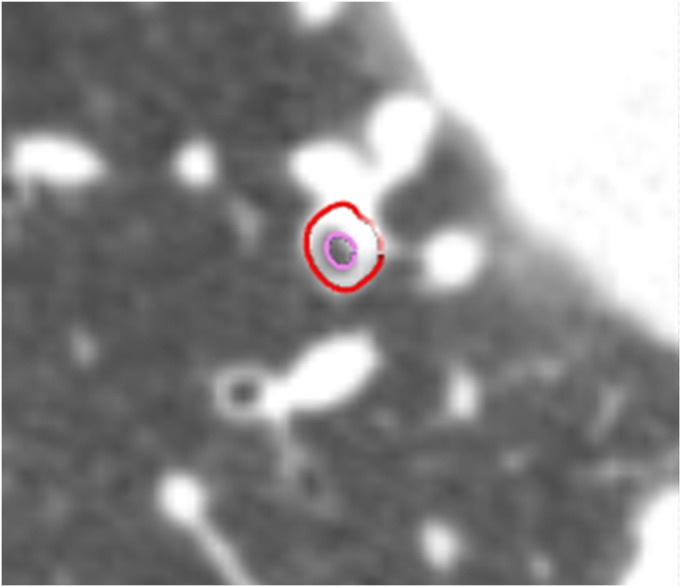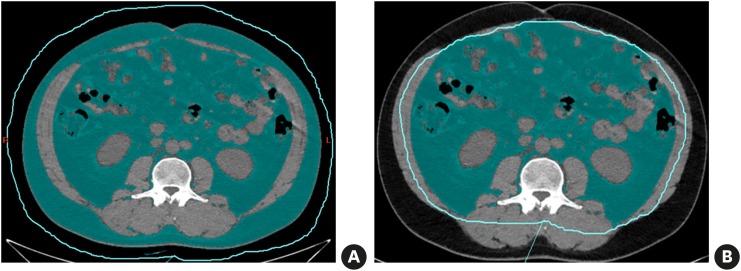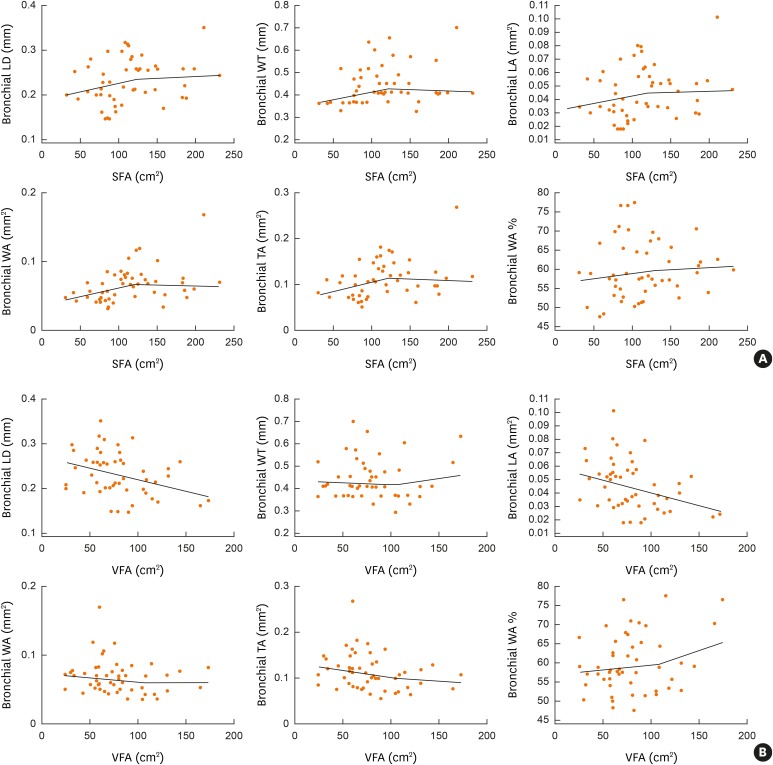Allergy Asthma Immunol Res.
2018 Sep;10(5):503-515. 10.4168/aair.2018.10.5.503.
Association Between Airway Parameters and Abdominal Fat Measured via Computed Tomography in Asthmatic Patients
- Affiliations
-
- 1Department of Internal Medicine, Seoul Metropolitan Government-Seoul National University Boramae Medical Center, Seoul, Korea.
- 2Department of Mechanical Engineering, Kyungpook National University, Daegu, Korea.
- 3Department of Radiology, Seoul Metropolitan Government-Seoul National University Boramae Medical Center, Seoul, Korea. wlsrhkdska@gmail.com
- KMID: 2418048
- DOI: http://doi.org/10.4168/aair.2018.10.5.503
Abstract
- PURPOSE
We aimed to investigate whether airway parameters, assessed via computed tomography (CT), are associated with abdominal fat areas and to compare the clinical characteristics of asthmatic patients with and without elevated visceral to subcutaneous fat area ratio (EV).
METHODS
Asthmatic patients (aged ≥40 years) were prospectively recruited. Chest (airway) and fat areas were assessed via CT. Airway parameters, including bronchial wall thickness (WT), lumen diameter (LD), lumen area (LA), wall area (WA), total area (TA), as well as WA/TA percentage (wall area %) were measured at the apical segmental bronchus in the right upper lobe. Visceral (VFA), subcutaneous (SFA) and total (TFA) fat areas (cm2) were also measured. The correlations between abdominal fat areas and airway parameters were assessed. EV was defined as VFA/SFA ≥ 0.4.
RESULTS
Fifty asthmatic patients were included (mean age 62.9 years; 52% female); 38% had severe asthma. Significant correlations were found between VFA and both LD and LA (r = −0.35, P = 0.01; r = −0.34, P = 0.02, respectively), and SFA and both WA and TA (r = 0.38, P = 0.007; r = 0.34, P = 0.02, respectively). Exacerbations, requiring corticosteroid therapy or ER visitation, were significantly more frequent in subjects without EV (83% vs. 34%, P = 0.05).
CONCLUSIONS
Abdominal fat is associated with asthma, according to the location of fat accumulation. In asthmatic subjects, visceral fat seems to be attributable to the bronchial luminal narrowing, while subcutaneous fat may be related to thickening of bronchial wall.
MeSH Terms
Figure
Reference
-
1. Dixon AE, Holguin F, Sood A, Salome CM, Pratley RE, Beuther DA, et al. An official American Thoracic Society Workshop report: obesity and asthma. Proc Am Thorac Soc. 2010; 7:325–335. PMID: 20844291.
Article2. Farah CS, Salome CM. Asthma and obesity: a known association but unknown mechanism. Respirology. 2012; 17:412–421. PMID: 21992497.
Article3. Brumpton B, Langhammer A, Romundstad P, Chen Y, Mai XM. General and abdominal obesity and incident asthma in adults: the HUNT study. Eur Respir J. 2013; 41:323–329. PMID: 22653771.
Article4. Gruchała-Niedoszytko M, Małgorzewicz S, Niedoszytko M, Gnacińska M, Jassem E. The influence of obesity on inflammation and clinical symptoms in asthma. Adv Med Sci. 2013; 58:15–21. PMID: 23729631.
Article5. Shore SA. Obesity and asthma: location, location, location. Eur Respir J. 2013; 41:253–254. PMID: 23370797.
Article6. Cho YS. Effective strategies for managing asthma exacerbations for precision medicine. Allergy Asthma Immunol Res. 2017; 9:463–465. PMID: 28913984.
Article7. Beuther DA, Sutherland ER. Overweight, obesity, and incident asthma: a meta-analysis of prospective epidemiologic studies. Am J Respir Crit Care Med. 2007; 175:661–666. PMID: 17234901.8. Pou KM, Massaro JM, Hoffmann U, Vasan RS, Maurovich-Horvat P, Larson MG, et al. Visceral and subcutaneous adipose tissue volumes are cross-sectionally related to markers of inflammation and oxidative stress: the Framingham Heart Study. Circulation. 2007; 116:1234–1241. PMID: 17709633.9. Kim SH, Sutherland ER, Gelfand EW. Is there a link between obesity and asthma? Allergy Asthma Immunol Res. 2014; 6:189–195. PMID: 24843792.
Article10. Eneli IU, Skybo T, Camargo CA Jr. Weight loss and asthma: a systematic review. Thorax. 2008; 63:671–676. PMID: 18663068.
Article11. Juel CT, Ali Z, Nilas L, Ulrik CS. Asthma and obesity: does weight loss improve asthma control? a systematic review. J Asthma Allergy. 2012; 5:21–26. PMID: 22791994.12. Shuster A, Patlas M, Pinthus JH, Mourtzakis M. The clinical importance of visceral adiposity: a critical review of methods for visceral adipose tissue analysis. Br J Radiol. 2012; 85:1–10. PMID: 21937614.
Article13. Oh YH, Moon JH, Kim HJ, Kong MH. Visceral-to-subcutaneous fat ratio as a predictor of the multiple metabolic risk factors for subjects with normal waist circumference in Korea. Diabetes Metab Syndr Obes. 2017; 10:505–511. PMID: 29270027.
Article14. Gradmark AM, Rydh A, Renström F, De Lucia-Rolfe E, Sleigh A, Nordström P, et al. Computed tomography-based validation of abdominal adiposity measurements from ultrasonography, dual-energy X-ray absorptiometry and anthropometry. Br J Nutr. 2010; 104:582–588. PMID: 20370942.
Article15. Oh YH, Moon JH, Kim HJ, Kong MH. Visceral-to-subcutaneous fat ratio as a predictor of the multiple metabolic risk factors for subjects with normal waist circumference in Korea. Diabetes Metab Syndr Obes. 2017; 10:505–511. PMID: 29270027.
Article16. Hwang HJ, Hoffman EA, Lee CH, Goo JM, Levin DL, Kauczor HU, et al. The role of dual-energy computed tomography in the assessment of pulmonary function. Eur J Radiol. 2017; 86:320–334. PMID: 27865580.
Article17. Park SJ, Lee CH, Goo JM, Kim JH, Park EA, Jung JW, et al. Quantitative analysis of dynamic airway changes after methacholine and salbutamol inhalation on xenon-enhanced chest CT. Eur Radiol. 2012; 22:2441–2450. PMID: 22736190.
Article18. Chen H, Zeng QS, Zhang M, Chen RC, Xia TT, Wang W, et al. Quantitative low-dose computed tomography of the lung parenchyma and airways for the differentiation between chronic obstructive pulmonary disease and asthma patients. Respiration. 2017; 94:366–374. PMID: 28738344.
Article19. Crapo RO, Casaburi R, Coates AL, Enright PL, Hankinson JL, Irvin CG, et al. Guidelines for methacholine and exercise challenge testing-1999. This official statement of the American Thoracic Society was adopted by the ATS Board of Directors, July 1999. Am J Respir Crit Care Med. 2000; 161:309–329. PMID: 10619836.20. Kwon HS, Lee SH, Yang MS, Lee SM, Kim SH, Kim DI, et al. Correlation between the Korean version of Asthma Control Test and health-related quality of life in adult asthmatics. J Korean Med Sci. 2008; 23:621–627. PMID: 18756048.
Article21. Choi S, Hoffman EA, Wenzel SE, Castro M, Fain S, Jarjour N, et al. Quantitative computed tomographic imaging-based clustering differentiates asthmatic subgroups with distinctive clinical phenotypes. J Allergy Clin Immunol. 2017; 140:690–700.e8. PMID: 28143694.
Article22. Fuhlbrigge A, Peden D, Apter AJ, Boushey HA, Camargo CA Jr, Gern J, et al. Asthma outcomes: exacerbations. J Allergy Clin Immunol. 2012; 129:S34–S48. PMID: 22386508.
Article23. Gupta S, Siddiqui S, Haldar P, Entwisle JJ, Mawby D, Wardlaw AJ, et al. Quantitative analysis of high-resolution computed tomography scans in severe asthma subphenotypes. Thorax. 2010; 65:775–781. PMID: 20805170.
Article24. Liu L, Li G, Sun Y, Li J, Tang N, Dong L. Airway wall thickness of allergic asthma caused by weed pollen or house dust mite assessed by computed tomography. Respir Med. 2015; 109:339–346. PMID: 25524508.
Article25. Choi S, Hoffman EA, Wenzel SE, Castro M, Fain SB, Jarjour NN, et al. Quantitative assessment of multiscale structural and functional alterations in asthmatic populations. J Appl Physiol (1985). 2015; 118:1286–1298. PMID: 25814641.
Article26. Neeland IJ, Ayers CR, Rohatgi AK, Turer AT, Berry JD, Das SR, et al. Associations of visceral and abdominal subcutaneous adipose tissue with markers of cardiac and metabolic risk in obese adults. Obesity (Silver Spring). 2013; 21:E439–E447. PMID: 23687099.
Article27. Ryo M, Kishida K, Nakamura T, Yoshizumi T, Funahashi T, Shimomura I. Clinical significance of visceral adiposity assessed by computed tomography: a Japanese perspective. World J Radiol. 2014; 6:409–416. PMID: 25071881.
Article28. Barton JH, Ireland A, Fitzpatrick M, Kessinger C, Camp D, Weinman R, et al. Adiposity influences airway wall thickness and the asthma phenotype of HIV-associated obstructive lung disease: a cross-sectional study. BMC Pulm Med. 2016; 16:111. PMID: 27488495.
Article29. Nishimoto K, Karayama M, Inui N, Mori K, Kono M, Hozumi H, et al. Relationship between fraction of exhaled nitric oxide and airway morphology assessed by three-dimensional CT analysis in asthma. Sci Rep. 2017; 7:10187. PMID: 28860527.
Article30. Shore SA. Obesity and asthma: possible mechanisms. J Allergy Clin Immunol. 2008; 121:1087–1093. PMID: 18405959.
Article31. King GG, Brown NJ, Diba C, Thorpe CW, Muñoz P, Marks GB, et al. The effects of body weight on airway calibre. Eur Respir J. 2005; 25:896–901. PMID: 15863649.
Article32. Lee JH, Han KD, Jung HM, Youn YH, Lee JY, Park YG, et al. Association between obesity, abdominal obesity, and adiposity and the prevalence of atopic dermatitis in young Korean adults: the Korea National Health and Nutrition Examination Survey 2008–2010. Allergy Asthma Immunol Res. 2016; 8:107–114. PMID: 26739403.
Article33. Song WJ, Kim SH, Lim S, Park YJ, Kim MH, Lee SM, et al. Association between obesity and asthma in the elderly population: potential roles of abdominal subcutaneous adiposity and sarcopenia. Ann Allergy Asthma Immunol. 2012; 109:243–248. PMID: 23010229.
Article34. Kim KM, Kim SS, Kwon JW, Jung JW, Kim TW, Lee SH, et al. Association between subcutaneous abdominal fat and airway hyperresponsiveness. Allergy Asthma Proc. 2011; 32:68–73. PMID: 21262101.
Article35. Conus S, Bruno A, Simon HU. Leptin is an eosinophil survival factor. J Allergy Clin Immunol. 2005; 116:1228–1234. PMID: 16337450.
Article36. Grotta MB, Squebola-Cola DM, Toro AA, Ribeiro MA, Mazon SB, Ribeiro JD, et al. Obesity increases eosinophil activity in asthmatic children and adolescents. BMC Pulm Med. 2013; 13:39. PMID: 23773659.
Article37. Kato H, Ueki S, Kamada R, Kihara J, Yamauchi Y, Suzuki T, et al. Leptin has a priming effect on eotaxin-induced human eosinophil chemotaxis. Int Arch Allergy Immunol. 2011; 155:335–344. PMID: 21346363.
Article38. Mclean AN, Sproule MW, Cowan MD, Thomson NC. High resolution computed tomography in asthma. Thorax. 1998; 53:308–314. PMID: 9741377.
Article39. Asker S, Asker M, Ozbay B. Evaluation of airway wall thickness via high-resolution computed tomography in mild intermittent asthma. Respir Care. 2014; 59:550–556. PMID: 24106318.
Article40. Gentile CL, Weir TL, Cox-York KA, Wei Y, Wang D, Reese L, et al. The role of visceral and subcutaneous adipose tissue fatty acid composition in liver pathophysiology associated with NAFLD. Adipocyte. 2015; 4:101–112. PMID: 26167414.
Article41. Foster MT, Pagliassotti MJ. Metabolic alterations following visceral fat removal and expansion: beyond anatomic location. Adipocyte. 2012; 1:192–199. PMID: 23700533.42. Wark PA, Gibson PG. Asthma exacerbations. 3: Pathogenesis. Thorax. 2006; 61:909–915. PMID: 17008482.43. Antonopoulos AS, Sanna F, Sabharwal N, Thomas S, Oikonomou EK, Herdman L, et al. Detecting human coronary inflammation by imaging perivascular fat. Sci Transl Med. 2017; 9:eaal2658. PMID: 28701474.
Article44. Antonopoulos AS, Margaritis M, Coutinho P, Digby J, Patel R, Psarros C, et al. Reciprocal effects of systemic inflammation and brain natriuretic peptide on adiponectin biosynthesis in adipose tissue of patients with ischemic heart disease. Arterioscler Thromb Vasc Biol. 2014; 34:2151–2159. PMID: 25060790.
Article45. Bambace C, Sepe A, Zoico E, Telesca M, Olioso D, Venturi S, et al. Inflammatory profile in subcutaneous and epicardial adipose tissue in men with and without diabetes. Heart Vessels. 2014; 29:42–48. PMID: 23296264.
Article46. Moore WC, Meyers DA, Wenzel SE, Teague WG, Li H, Li X, et al. Identification of asthma phenotypes using cluster analysis in the Severe Asthma Research Program. Am J Respir Crit Care Med. 2010; 181:315–323. PMID: 19892860.
Article47. Haldar P, Pavord ID, Shaw DE, Berry MA, Thomas M, Brightling CE, et al. Cluster analysis and clinical asthma phenotypes. Am J Respir Crit Care Med. 2008; 178:218–224. PMID: 18480428.
Article48. Kim TB, Jang AS, Kwon HS, Park JS, Chang YS, Cho SH, et al. Identification of asthma clusters in two independent Korean adult asthma cohorts. Eur Respir J. 2013; 41:1308–1314. PMID: 23060627.
Article49. Gupta S, Hartley R, Khan UT, Singapuri A, Hargadon B, Monteiro W, et al. Quantitative computed tomography-derived clusters: redefining airway remodeling in asthmatic patients. J Allergy Clin Immunol. 2014; 133:729–738.e18. PMID: 24238646.
Article50. Walker C, Gupta S, Hartley R, Brightling CE. Computed tomography scans in severe asthma: utility and clinical implications. Curr Opin Pulm Med. 2012; 18:42–47. PMID: 22112997.
- Full Text Links
- Actions
-
Cited
- CITED
-
- Close
- Share
- Similar articles
-
- Gastrointestinal Gas and Abdominal Fat Quantity Measured by Three-Dimensional Abdominal Computed Tomography in Patients with Functional Bloating
- Computed tomographic evaluation of abdominal fat in minipigs
- The Correlation Between Visceral Fat Distance Measured by Ultrasonography and Visceral Fat Amount by Computed Tomography in Type 2 Diabetes
- The Correlation between the Triglyceride to High Density Lipoprotein Cholesterol Ratio and Computed Tomography-Measured Visceral Fat and Cardiovascular Disease Risk Factors in Local Adult Male Subjects
- Relationship between Abdominal Fat Area Measured by Screening Abdominal Fat CT and Metabolic Syndrome in Asymptomatic Korean Individuals




